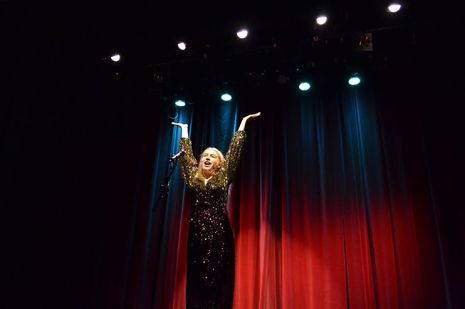The Rise and Fall of Little Voice is musically delightful, if sometimes off-beat
Iris Pearson is charmed by Little Voice’s singing, even if the play itself could do with a bit more consistency

Jim Cartwright’s The Rise and Fall of Little Voice is a study of what it means to listen and be listened to. Georgina Deri’s production at the ADC showcases vocal and directorial talent, but it needs more volume and better focus on tone.
Jonathan Powell and Charli Foreman’s double-layer set divides the eye, but it also plays games with the ear in this play. Little Voice (referred to as “LV” by the other characters and played by Lydia Clay-White) sings from “upstairs”, unaware that the characters bustling down below can hear her. They wonder in disbelief at the disembodied sound which could be coming straight from the record player. Neither they nor the audience can see her moving lips; at first, Little Voice is heard but not seen.
It is a shame, however, that some of the most powerful scenes take place far away from the audience, on this upper section of the set. Billy (Charlie Morrell-Brown) leans in through the window to talk to LV in what I think is the play’s most inventive directorial moment, but some of the intimacy of the exchange is lost by its physical distance from the audience. Perhaps a side-by-side set would have worked better, giving the scenes in LV’s bedroom greater weight and centrality – but then again, perhaps the fact that she is hidden away, pushed to a small space at the top of the set, is symbolic.
"Clay-White’s voice is breath-taking...I was mesmerised, lost in her voice"
Clay-White’s voice is breath-taking. I want to watch a whole show of her singing. I was mesmerised, lost in her voice, but then I was jolted back again by her next impression; I was, and still am, open-mouthed at her talent. The directorial decision to have her perform her first show in the dark is particularly effective, tantalising the audience, cruelly withholding the glory of her full performance. LV’s frenzied medley at the end of the play as she pushes back against Ray trembles with the instability of talent pushed too far, but presents, too, the power of music more generally in this play. Music is the background to these characters’ lives, emerging even in the ring of the telephone and a knock on the door. Music liberates, music celebrates (see the Jackson 5 dance, this one’s a treat), and music rebels against oppositional forces. Through music, LV rises, falls, and then finally triumphs.
Clay-White’s voice carries the end of the play. The final scene between LV and Billy thrills with emotion and new hope, like a performance organically crafted between two young people who are on the cusp of finding their own voices. There is a tenderness between the two characters which is not overplayed but subtly present, and Morrell-Brown looks on from the side of the stage with a perfect mixture of pride, excitement and adoration. I want to watch more of this scene; I want to hear Clay-White sing again.
Where this production falls short, for me, is its negotiation of tone and pace. While Harriet Wilton as Mari is brilliant and multi-layered, revealing underneath her bawdy jokes a sensitive widow and mother worrying about how to get by, I think her vulgarity could have been louder. If Mari’s scenes in the kitchen were more over the top, then the stunned silence which falls when LV starts to sing would be more pronounced. Similarly, I think there is a problem of tone in the final scene. Connor Rowlett delivers Ray’s outburst with a spitting vitriol which is perfect for that moment of breakdown, but there needs to be more build-up to this outburst; Wilton and Rowlett should show us more over the course of this scene that something is going wrong: that love, if it was ever love, is turning to hatred. As it was last night, I was shocked by Ray’s outburst, but I was more shocked by the language in isolation than his toxic trajectory.
There is no shortage of talent in this production. Clay-White’s voice alone could hold the stage, and she is supported by a group of accomplished actors. I think that more attention to tonal dynamics and to the possibilities of staging would open this show up to its full potential and embrace the emotional intensity of Cartwright’s story about a star first pushed, then stepping, into the spotlight.
 News / Cambridge academics stand out in King’s 2026 Honours List2 January 2026
News / Cambridge academics stand out in King’s 2026 Honours List2 January 2026 Interviews / You don’t need to peak at Cambridge, says Robin Harding31 December 2025
Interviews / You don’t need to peak at Cambridge, says Robin Harding31 December 2025 Comment / What happened to men at Cambridge?31 December 2025
Comment / What happened to men at Cambridge?31 December 2025 Features / “It’s a momentary expression of rage”: reforming democracy from Cambridge4 January 2026
Features / “It’s a momentary expression of rage”: reforming democracy from Cambridge4 January 2026 News / Varsity’s biggest stories of 202531 December 2025
News / Varsity’s biggest stories of 202531 December 2025










